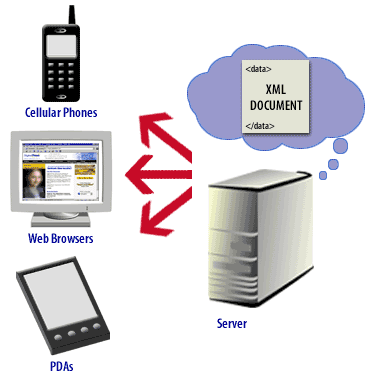| Lesson 7 | Using XML |
| Objective | Describe approaches to using XML. |
Describe Approaches to using XML
XML promotes easy data exchange and because XML documents are text-based documents, they can be easily created, manipulated, stored, and transmitted. There is no need to worry about any proprietary data formats, one of the problems that hindered the easy exchange of data
between applications. XML documents can also be easily distributed and displayed on the Web.
XML uses beyond the Web
XML documents contain data inside custom tags that describe the data. Once an XML document is created, it may be shared to take advantage of the data content or rendered by multiple devices. The same XML document may be viewed on browser, a Personal Digital Assistant (PDA), or a cell phone. In each case, the XML document will transformed so that it can be viewed in
the respective device. For example, there are software programs that will transform an XML document into an HTML document so that the later may be rendered by a browser. This creates an environment where pervasive computing becomes a real possibility: the same XML document is transformed and viewed by many different devices.
What are some of the Approaches to using XML
There are several approaches to using XML, including the following:
- Document-centric: This approach is used to represent data in a way that is easily understood by humans. XML documents are used to store and transmit data in a format that is both human-readable and machine-readable.
- Data-centric: This approach is used to represent data in a way that is easily understood by machines. XML documents are used to store data in a format that can be easily parsed and processed by software applications.
- Hybrid: This approach combines elements of both document-centric and data-centric approaches. XML documents are used to store data in a format that is both human-readable and machine-readable, and can be easily parsed and processed by software applications.
- Service-oriented architecture: This approach uses XML as a common data format for exchanging information between different systems and applications. XML is used to define the structure of the data being exchanged and the rules for processing it.
- XML-based standards: Many XML-based standards such as SOAP, WSDL, and UDDI are used for Web Services.
- XSLT: XSLT (eXtensible Stylesheet Language Transformations) is a language used to transform XML documents into other formats, such as HTML or PDF.
- XML Schema: XML Schema is a language used to define the structure and constraints of XML documents, allowing for the creation of custom markup languages that can be used to represent domain-specific data in a way that is easily understood by both humans and machines.

XML as a metalanguage
With XML, one can create customized markup languages that are also extensible.
Many such languages are appearing in vertical business domains. Here are some examples:
XML Advantages
- Financial Exchange (IFX)
- Bank Internet Payment System (BIPS)
- Telecommunications Interchange Markup (TIM)
- Product Data Markup Language (PDML)
- Financial Information eXchange Protocol (FIX)
XML Advantages